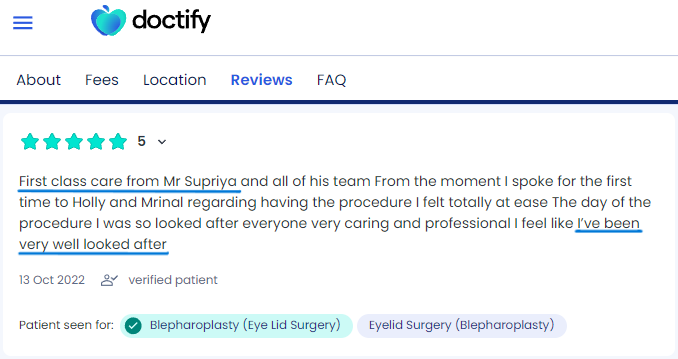Struggling with Droopy Eyelids or
Excess Skin? We Can Help!
Are you self-conscious about the appearance of your upper and lower eyelids? Do you have saggy upper eyelid skin that affects your vision or gives you a tired look? At British Face Clinic, we understand how these concerns can impact your confidence and well-being.
Blepharoplasty surgery can address these issues, giving you a more youthful appearance and improved quality of life. We offer expert blepharoplasty in London, Milton Keynes and Northampton, ensuring you have access to top-quality care in a location that suits you best.
Before and After Images of Blepharoplasty
These before and after photos show the effectiveness of the
blepharoplasty performed by Mr Mrinal Supriya and his team.
The above pictures are authentic and unedited photos of Mr Supriya patients.
What is Blepharoplasty and
What Can It Do For You?
Blepharoplasty, also known as eyelid surgery or aesthetic eyelid surgery, is a low-risk cosmetic surgical procedure designed to remove excess skin and fat from the upper and lower eyelids. This procedure can enhance your appearance by reducing droopy eyelids, puffiness and bags under your eyes, giving you a refreshed and youthful appearance. The benefits include:
- Removing excess skin and fat
- Reducing saggy upper eyelid skin
- Improving peripheral vision obstructed by droopy eyelids
- Enhancing facial symmetry
Blepharoplasty at a Glance
Duration
40 – 60 minutes
Anaesthesia
General or local or twilight anaesthetics for both upper and lower blepharoplasty

Bandages
Not usually required after surgery

Hospital Stay
Daycase with no overnight stay

Downtime
1 – 3 weeks

Exercise
After 6 weeks
Cost
Consultation – £100 Procedure from £5,000

Results
Full recovery 6 – 9 months
Duration
40 – 60 minutes
Anaesthesia
General or local or twilight anaesthetics for both upper and lower blepharoplasty

Bandages
Not usually required after surgery

Hospital Stay
Daycase with no overnight stay

Downtime
1 – 3 weeks

Exercise
After 6 weeks
Cost
Consultation – £100
Procedure from £5,000

Results
Full recovery 6 – 9 months
Is Blepharoplasty
Right for You?
You might be an ideal candidate for blepharoplasty if:
- You wish to improve the appearance of your upper and lower eyelids
- Excess skin or fat has altered your eyelids’ shape
- Droopy eyelids obstruct your vision
- You have sagging skin due to ageing
- You seek a more youthful and alert appearance
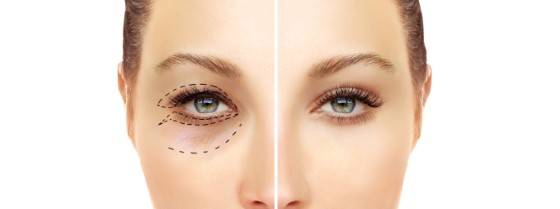
Blepharoplasty London: Enhance your appearance and vision with expert blepharoplasty services tailored to your needs.
Consultation
We offer a free initial phone consultation with our specialist team. For the next step, we invite you to an in-person or online consultation with Mr Supriya. Consultations are £100 with Mr Supriya and are deductible from any booked surgery. This fee includes follow-up consultations.
Types of Blepharoplasty
Procedures We Offer
Upper Eyelid Surgery
This procedure, also known as upper blepharoplasty or upper eyelid blepharoplasty, involves removing excess skin and fat from the upper eyelids to eliminate droopy eyelids and improve vision.
Lower Eyelid Surgery
This surgical procedure addresses sagging skin and excess fat in the lower eyelids, reducing bags and puffiness for a smoother, more youthful appearance.
Scarless Transconjunctival
Lower Blepharoplasty
This is an excellent option for patients who have primarily fat prolapse under the lower eyelid with limited excess skin or muscle. In this technique, Mr Supriya will use a cut made inside the lower eyelid i.e lower conjunctiva, to access and remove or translocate excess fat. This avoids any external scar and has lesser bruising and swelling externally. In some cases this can be combined with limited skin cuts to remove excess skin.
Combined Upper and
Lower Eyelid Surgery
For comprehensive rejuvenation, we offer combined upper and lower blepharoplasty to treat both upper and lower eyelids in a single procedure.
Upper Eyelid Surgery
This procedure, also known as upper blepharoplasty or upper eyelid blepharoplasty, involves removing excess skin and fat from the upper eyelids to eliminate droopy eyelids and improve vision.
Lower Eyelid Surgery
This surgical procedure addresses sagging skin and excess fat in the lower eyelids, reducing bags and puffiness for a smoother, more youthful appearance.
Scarless Transconjunctival Lower Blepharoplasty
This is an excellent option for patients who have primarily fat prolapse under the lower eyelid with limited excess skin or muscle. In this technique, Mr Supriya will use a cut made inside the lower eyelid i.e lower conjunctiva, to access and remove or translocate excess fat. This avoids any external scar and has lesser bruising and swelling externally. In some cases this can be combined with limited skin cuts to remove excess skin.
Combined Upper and Lower Eyelid Surgery
For comprehensive rejuvenation, we offer combined upper and lower blepharoplasty to treat both upper and lower eyelids in a single procedure.
Patient Stories
It’s embarrassing looking tired at work, and social events aren’t so fun when your confidence and self-esteem are lacking. You’ve neglected yourself and feel inadequate compared to all the beautiful people around you. You deserve some self-love.
Take your first step and step into a more beautiful you!
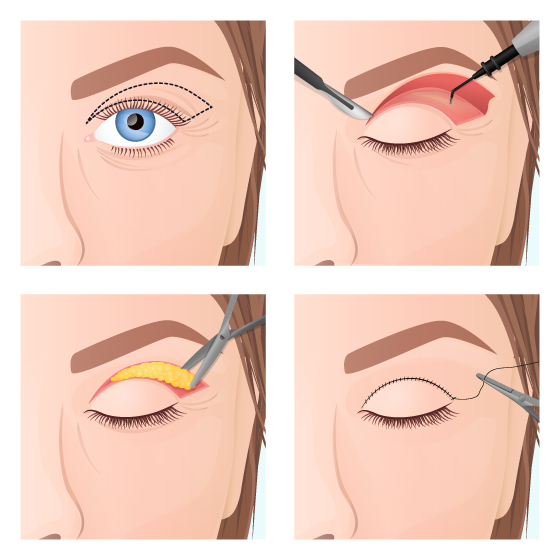
Blepharoplasty London: Remove excess skin and fat from your eyelids for a refreshed and youthful look.
Blepharoplasty combined with other facial rejuvenation
Depending on the need and desire, blepharoplasty is commonly done along with the following procedures in the same day
- Blepharoplasty with forehead/eyebrow repositioning
- Blepharoplasty with mid face lift
- Blepharoplasty with fat injection/grafting
- Blepharoplasty with deep plane face and neck lift
How Blepharoplasty (Eyelid Surgery) Works
Blepharoplasty surgery involves making incisions in the natural folds of the eyelids to remove or reposition excess skin and fat. The procedure typically lasts around 20-25 minutes per eyelid and recovery time is about a week. Here’s a brief overview of the process:
- Upper Eyelid Surgery: Incisions are made in the natural crease of the upper eyelid to remove excess skin and fat.
- Lower Eyelid Surgery: Incisions are made just below the eyelashes or inside the lower eyelid to address bags and puffiness. As explained above in suitable cases, the incision can be made inside the eyelid to avoid any visible scar.In both technique, Mr Supriya will also lift the muscle of lower eyelid and tighten the eyelash line.
Why Undergo Eyelid Surgery?
As you age, your skin loses elasticity, leading to sagging skin, wrinkles and bags around your eyes. Blepharoplasty surgery can:
- Remove excess skin and fatty tissue
- Reduce wrinkles and bags
- Eliminate dark circles
- Strengthen weakened eye muscles
Undergo eyelid surgery to appear more youthful, boost your confidence and improve your vision if obstructed by sagging skin.
Blepharoplasty Risks
Eyelid surgery is a very safe and effective procedure and choosing the right surgeon will further minimise any risks associated with this type of surgery. It is important, however, to know what the potential complications of any surgery may be:
- Possible infection and bleeding
- Dry, irritated eyes
- Difficulty closing your eyes – or other eyelid problems
- Noticeable scarring
- Injury to eye muscles causing double vision
- Out-turning of lower eyelid/eyelash (ectropion) leading to asymmetry and excessive watering
- Rounded appearance of outer eye corner
- Skin discoloration
- The need for a follow-up surgery
- Temporary blurred vision or, in very rare cases, loss of eyesight
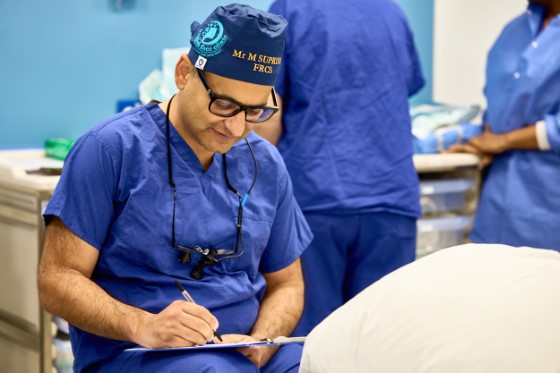
Blepharoplasty London: Book a consultation today to discuss how cosmetic eyelid surgery can improve your quality of life.
Pre-Operative Instructions & Recovery
Pre-Operative Instructions
- Wash your face, body and hair with antibacterial soap the night before and on the morning of your surgery
- Do not wear any skin products, makeup, or fragrances from the neck up
- Avoid aspirin or any drug that increases bleeding two weeks before surgery
- Do not eat or drink anything 8 hours before surgery if having general anaesthesia
- Remove all jewellery and wear loose clothing
- Arrange for someone to drive you home and stay with you after surgery
Blepharoplasty Recovery Timeline
- 1st Day Post-Op: You will return home the same day. Expect swelling, tightness and bruising. Use antiseptic ointment and eye drops as prescribed.
- 1 Week Post-Op: Stitches are removed and bruising and swelling will start to subside.
- 1 Month Post-Op: Continued healing with reduced swelling and any remaining pink scars fading.
- Full Recovery: After 6-9 months, all swelling and scarring will have subsided, revealing your final results.
Post-Operative Recovery Advice
- Use ice or cold compresses for the first 72 hours
- Shower 48 hours after surgery and gently wash the face
- Apply antiseptic ointment to the stitches every 4-6 hours
- Use prescribed eye drops to keep your eyes hydrated
- Keep your head and neck elevated to reduce swelling
- Avoid direct sunlight and use sunblock with UV protection
Reclaim your youthful face. Reclaim your self-assurance.
Why Mr Mrinal Supriya Is Your
Best Choice for Blepharoplasty
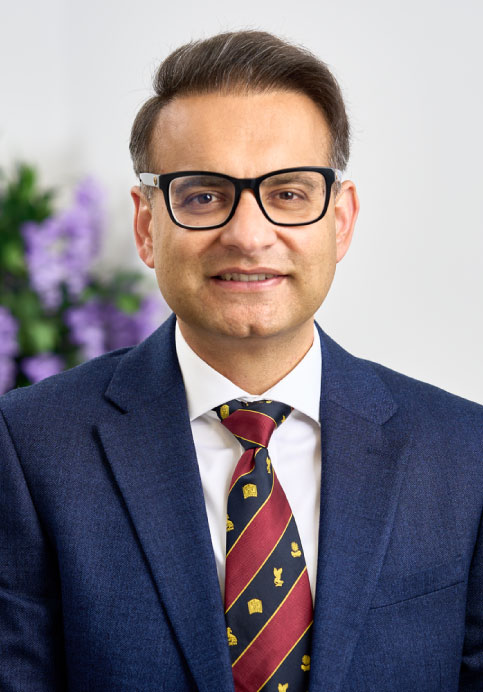
Meet Mr Mrinal Supriya | Facial Cosmetic Surgeon
FRCS (OTOL-HNS), MRCS Ed,
DO-HNS, MS in ENT, MBBS
Mr Mrinal Supriya is the Divisional Director of Surgery. He is highly experienced Head and Neck Surgeon, specialising in facial cosmetic surgery. He is Chief of Surgery Division (2024) and was the Clinical Director for head and neck surgery at Northampton General Hospital.
He leads complex ENT and head and neck services, including facial aesthetics & reconstruction and robotic surgery. Mr Supriya trained globally, including in the UK, Australia and the USA and worked with renowned experts like Dr Andrew Jacono. He is certified by The Royal College of Surgeons to provide facial cosmetic surgery in the UK.
Why Choose British Face Clinic for
Your Blepharoplasty Procedure?
- Focus on natural-looking outcomes and high patient satisfaction
- Benefit from Mr Supriya’s international experience
- Advanced surgical services led by Mr Supriya at a prominent NHS hospital
- Expertise in training Oxford Deanery Trainee Surgeons
- Address both cosmetic and medical issues with comprehensive care
- Exceptionally low revision rates
- Best possible support before, during and after surgery with dedicated team access
How to schedule a consultation
To schedule a consultation to discuss a blepharoplasty procedure, you can either call us on 07590817036, book online via our website, schedule a video consultation or visit us at one of our clinics in London, Milton Keynes, or Northampton.
What to Expect During
Your Consultation
Welcome Message from Nidhi,
Director at British Face Clinic
During your full medical consultation, we’ll discuss:
- Your surgical goals
- Medical conditions, drug allergies and medical treatments
- Current medications, vitamins, supplements, alcohol, tobacco and drug use
- Previous surgeries
Our surgeon will:
- Evaluate your general health and risk factors
- Take photographs
- Discuss your surgical options
- Recommend a treatment course
- Discuss likely outcomes and potential complications
- Preview your surgical outcome with Crisalix 3D technology (for selected procedures)
- Discuss the surgery cost and payment options
How Much Does a Blepharoplasty
Cost in London?
The cost of Blepharoplasty is dependent on whether you undergo an upper or lower Blepharoplasty, or have both done. The type of anaesthetic and hospital location can also affect the cost. You will be provided with an accurate cost estimate at your initial consultation.
Holly, Practice Manager, Explains Why to Choose British
Face and What to Expect in the Procedure Cost
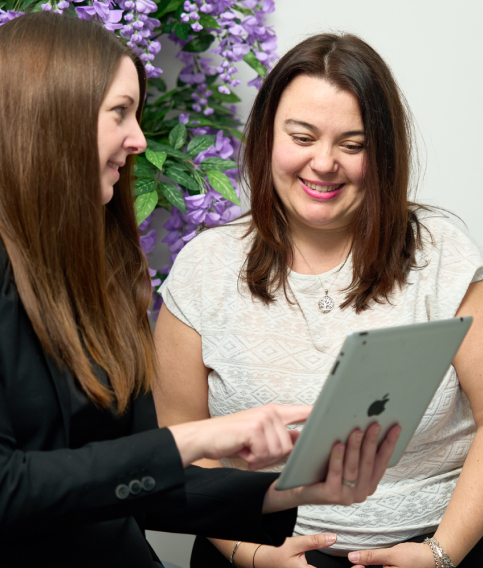
Accessible Payment
Plans Now Available
We make your procedure more accessible by offering flexible payment plans with 0% interest for the first 12 months!
It takes less than a minute to fill in the form and receive a response. Blepharoplasty has never been so accessible!
0% financing available
Change Your Life Today
The rejuvenate face of your dreams is just a free phone consultation away.
You can get the youthful and confident look you always desired.
Frequently Asked Questions
What Does Blepharoplasty Surgery Involve?
Blepharoplasty surgery involves making precise incisions along the natural creases of your eyelids to remove or reposition excess skin and fat. For upper eyelid surgery, the incisions are typically made within the natural folds of the upper eyelids. For lower eyelid surgery, incisions can be made just below the lash line or inside the lower eyelid.
Is Cosmetic Eyelid Surgery Safe?
Yes, cosmetic eyelid surgery is generally safe when performed by an experienced and qualified surgeon. As with any surgical procedure, there are risks, but complications are rare and usually minor. Choosing a skilled surgeon like Mr Supriya can further minimise these risks.
What is a Blepharoplasty Upper Eyelid Lift?
A blepharoplasty upper eyelid lift is a procedure aimed at removing excess skin and fat from the upper eyelids. This helps eliminate droopy eyelids and can improve vision if sagging skin obstructs it. The result is a more youthful and alert appearance.
Will I Have Visible Scars After Blepharoplasty Eyelid Surgery?
The incisions made during blepharoplasty eyelid surgery are strategically placed within the natural folds of the eyelids or inside the lower eyelid, making them almost invisible once healed. Scarring is minimal and typically fades significantly over time.
How Long Do the Results of Blepharoplasty Last?
The results of blepharoplasty can be long-lasting, with many patients enjoying the benefits for several years. While the natural ageing process continues, the improvements from the surgery are usually permanent, especially when accompanied by a healthy lifestyle and proper skincare.
Is Blepharoplasty Surgery Painful?
Most patients experience mild to moderate discomfort during the initial recovery period after blepharoplasty surgery. Pain is usually well-managed with prescribed painkillers and other post-operative care instructions. Most discomfort subsides within the first week.
Can Blepharoplasty Improve My Vision?
Yes, blepharoplasty can improve peripheral vision if droopy eyelids or excess skin are obstructing your field of vision. By removing the excess tissue, the surgery can enhance both your appearance and visual function.
What Are the Potential Risks of Blepharoplasty?
While blepharoplasty is generally safe, potential risks include infection, bleeding, dry or irritated eyes, difficulty closing the eyes, noticeable scarring and, in rare cases, injury to the eye muscles or temporary blurred vision. Discussing these risks with your surgeon can help you make an informed decision.
Our Locations
- London City
The Wellington Hospital, 15 – 17 Lodge Road
London NW8 7JA
- London City
98 Harley Street
London, W1G 7HZ
- Milton Keynes
Athena Surgical Centre
16 Davy Avenue, Knowlhill
Milton Keynes, MK5 8PL
- Northampton
The Three Shires Hospital
The Avenue
Northampton. NN1 5DR
London City
The Wellington Hospital
15 – 17 Lodge Road
London NW8 7JA
London City
98 Harley Street
London, W1G 7HZ
Milton Keynes
Athena Surgical Centre
16 Davy Avenue, Knowlhill
Milton Keynes, MK5 8PL
Northampton
The Three Shires Hospital
The Avenue
Northampton. NN1 5DR










